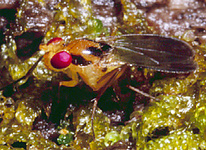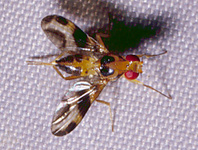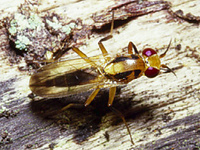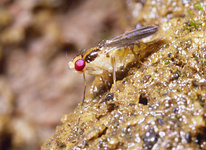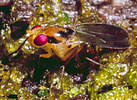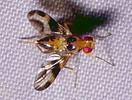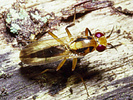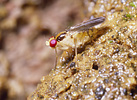Sobarocephala
Owen Lonsdale and Steve Marshall- Sobarocephala archisobarocephala group
- Sobarocephala erwini group
- Sobarocephala flava group
- Sobarocephala flaviseta group
- Sobarocephala interrupta group
- Sobarocephala isla group
- Sobarocephala latifrons group
- Sobarocephala latipennis group
- Sobarocephala plumicornis group
- Sobarocephala rubsaameni group
- Sobarocephala setulocetra group
Introduction
Sobarocephala Czerny is a predominantly New World taxon and the largest clusiid genus. Most species occur in the Nearctic or Neotropical Regions, but seven species are known from Australia, South Africa, Seychelles, and Southeast Asia.
Little is known of the biology of Sobarocephala, although adults of most North American species are commonly found around fallen, bare tree trunks under partial shade in moist, predominantly deciduous woodland (Malloch 1918, Sabrosky & Steyskal 1974). In Ontario, S. atricornis Sabrosky & Steyskal has been collected around Impatiens L., sedges and ferns. Sobarocephala flava has been collected in association with or amongst Poa L., Agrostis L., Phleum L., Festuca L. and Juncus L., and S. latifacies has been collected by sweep-netting in Impatiens, Clematis L., Rubus L. and grasses. In Saskatchewan, S. lachnosternum Melander & Argo has been caught in grasses in birch/poplar woodlands. In the Neotropical Region, specimens have often been observed on dung, especially on logs and around damp, mossy areas near water. Aside from dung, adults have been known to feed on nectar, sap and decaying vegetation (Malloch 1918).
Characteristics
Sobarocephala is an incredibly diverse genus of well over 200 species that can be very difficult to characterize, largely due to the fact that only a portion of species have retained all of the genus and subfamily level synapomorphies (Lonsdale & Marshall in manuscript). As a result, a combination of characters is usually necessary to diagnose the genus: externally, vein R1 is bare, the presutural intra-alar bristle is (almost always) absent, cell bm is often open (confluent with cell dm), and the mid tibia always has a dorsal preapical bristle.
The only synapomorphies defining Sobarocephala are male genitalic: the distiphallus has an additional shield-like sclerite at its base, and the lateral lobe of the distiphallus has an accessory 'thumb-like' extension (Lonsdale & Marshall in press). The thumb-like structure is frequently reduced or absent, but the basal shield is almost always present.
Sobarocephala somewhat resembles the sobarocephaline genera Chaetoclusia and Procerosoma, but vein R1 of Chaetoclusia is always setulose, and Procerosoma is missing several cephalic bristles, some notal bristles and all dorsal preapical tibial bristles. Heteromeringia is most often confused for Sobarocephala, but very few Sobarocephala are as darkly pigmented, and Heteromeringia has highly derived male and female genitalia, one minute lateral scutellar bristle, and no dorsal preapical tibial bristles.
Phylogenetics
The genera Sobarocephala and Procerosoma together form the sister group to the small neotropical genus Chaetoclusia. These three genera comprise the subfamily Sobarocephalinae, which was described and revised by Lonsdale & Marshall (in press).
Sobarocephala can be divided into 11 species groups (to be named the S. archisobarocephala, S. erwini, S. flava, S. flaviseta, S. interrupta, S. isla, S. latifrons, S. latipennis, S. plumicornis, S. rubsaameni and S. setulocetra species groups) that are almost entirely defined by male genitalic characters (Lonsdale & Marshall, in manuscript). Only one species group can be reliably identified using an external synapomorphy, the S. flaviseta group, which is defined (in part) on a frons that strongly narrows towards the back of the head. This is the largest of the 11 groups, and almost every species is characterized by either a densely plumose arista or ivory-white patches on the notum (Lonsdale & Marshall, in manuscript).
Relationships between the species groups of Sobarocephala are largely unknown, and molecular data will likely be necessary to resolve them.
References
Lonsdale, O & Marshall, S.A. In press, a. Redefinition of the Clusiinae and Clusiodinae, description of the new subfamily Sobarocephalinae, revision of the genus Chaetoclusia and a description of Procerosoma gen. nov. (Diptera: Clusiidae). European Journal of Entomology.
Malloch, J.R. 1918. A revision of the dipterous family Clusiodidae (Heteroneuridae). Proc. Ent. Soc. Wash. 20(1): 2-8.
Sabrosky, C.W. & G.C. Steyskal. 1974. The genus Sobarocephala (Diptera: Clusiidae) in America North of Mexico. Ann. Ent. Soc. Amer. 67(3): 371-385.
Soos, A. 1987. Clusiidae. In Manual of the Nearctic Diptera, Vol. 2, coordinated by J.F. McAlpine et al., Research branch, Agriculture Canada, Ottawa, pp. 853-857.
Title Illustrations
| Scientific Name | Sobarocephala sp. n. |
|---|---|
| Location | Neotropics |
| Specimen Condition | Live Specimen |
| Copyright | © 2004 Steve Marshall |
| Scientific Name | Soberocephala rubsaameni |
|---|---|
| Location | Neotropics |
| Specimen Condition | Live Specimen |
| Copyright | © 2004 Steve Marshall |
| Scientific Name | Sobarocephala picta |
|---|---|
| Location | Neotropics |
| Specimen Condition | Live Specimen |
| Copyright | © 2004 Steve Marshall |
| Scientific Name | Sobarocephala sp. 1 |
|---|---|
| Specimen Condition | Live Specimen |
| Life Cycle Stage | Adult |
| Copyright | © Steve Marshall |
About This Page
Owen Lonsdale
Insect Systematics Lab
Department of Environmental Biology
University of Guelph
Guelph, ON
N1G 2W1
Canada
Steve Marshall
Insect Systematics Lab
Department of Environmental Biology
University of Guelph
Guelph, ON
N1G 2W1
Canada
Correspondence regarding this page should be directed to Owen Lonsdale at and Steve Marshall at
Page copyright © 2005 Owen Lonsdale and Steve Marshall
- First online 25 August 2005
Citing this page:
Lonsdale, Owen and Marshall, Steve. 2005. Sobarocephala. Version 25 August 2005 (under construction). http://tolweb.org/Sobarocephala/27670/2005.08.25 in The Tree of Life Web Project, http://tolweb.org/





